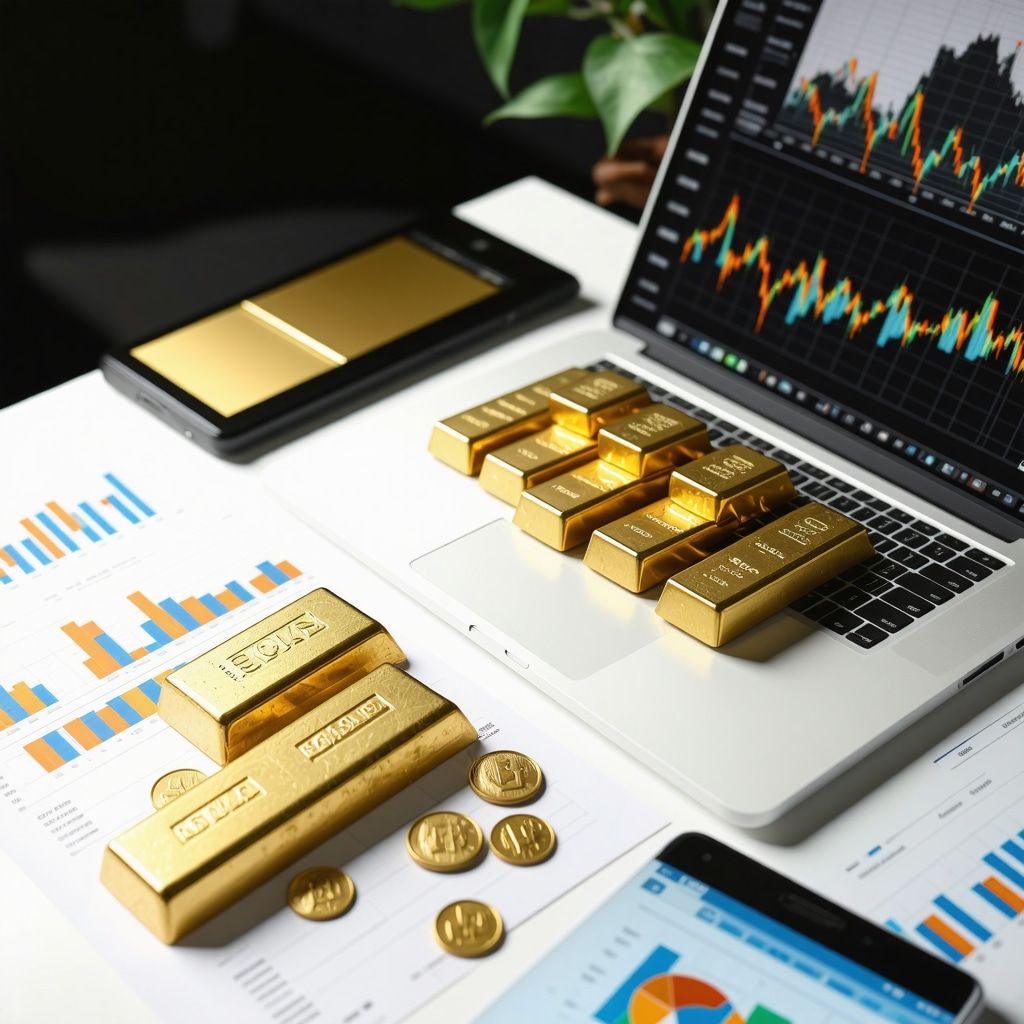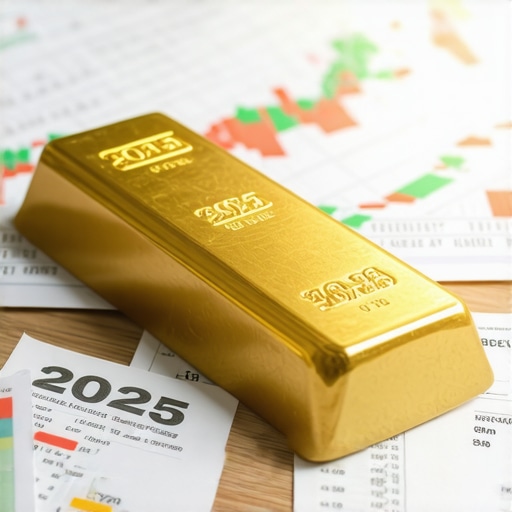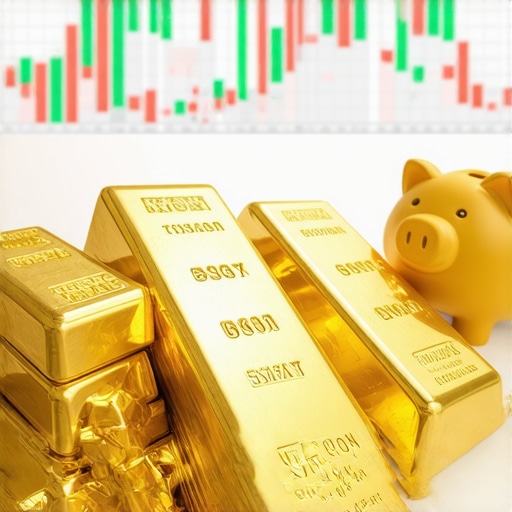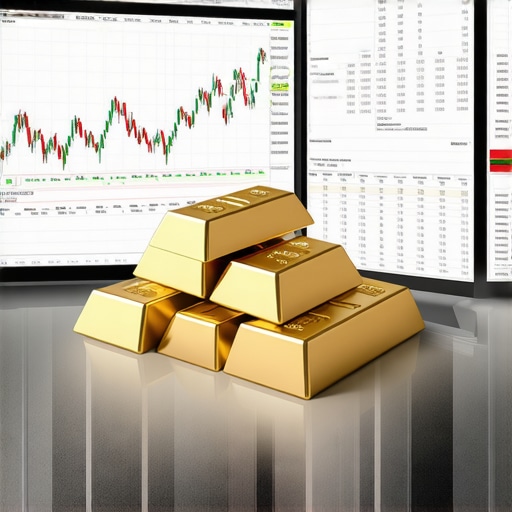Unlocking the Treasure Chest: Why Gold ETFs and Mutual Funds Are the Talk of 2026
Ah, gold! The timeless metal that’s dazzled kings and commoners alike for centuries. But in 2026, the game isn’t just about shiny bars hidden in vaults — it’s about digital dexterity and smart portfolio moves through Gold ETFs and Mutual Funds. Imagine investing in gold without the hassle of physical storage, security worries, or the grimace-inducing premiums on coins and bars. Welcome to the future of gold investing, where you can sip your morning coffee while your portfolio gleams.
Gold ETFs vs Mutual Funds: The Duel of Digital Gold
Before you dive headfirst into this glittering pool, let’s chat about these two popular vehicles. Gold ETFs (Exchange-Traded Funds) are like the sprinters of gold investments — they trade on stock exchanges, providing instant liquidity and pricing transparency. Mutual Funds, meanwhile, are the marathon runners, managed actively with a focus on steady growth and diversification, ideal for those who prefer a hands-off approach.
Which Sparkles Brighter for Your 2026 Goals?
Are you a day trader chasing fast moves, or a patient investor with an eye on long-term wealth? Gold ETFs offer the flexibility to seize market swings, while mutual funds provide the comfort of professional management and dividend opportunities. It’s not just about picking the shiniest option but matching your personality and financial goals with the right tool.
What Makes a Gold ETF or Mutual Fund a Keeper?
Let’s get down to brass tacks (or should we say gold flakes). Look for funds with low expense ratios — because high fees can erode your golden gains faster than you can say “bullion.” Check the fund’s track record, liquidity, and the size of assets under management. And don’t forget the pedigree of the fund manager; expertise here can mean the difference between glitter and gloom.
Another golden nugget: consider how the fund sources its gold exposure. Does it hold physical gold, futures contracts, or shares in mining companies? Each comes with distinct risks and rewards, so a savvy investor will weigh these carefully.
Why 2026 Is the Year to Strike While the Gold Is Hot
Economic uncertainty and inflation fears are the perfect storm brewing for gold’s resurgence. According to Investopedia’s analysis on inflation and gold prices, gold shines brightest when fiat currencies wobble. Plus, central banks worldwide are quietly stacking their vaults, subtly pushing demand up. This makes 2026 a potentially lucrative year for gold investments, especially through ETFs and mutual funds that offer agility and diversification.
Ready to Dive Into the Golden Pond?
If you’re itching to explore further, why not check out the Ultimate Guide to Gold ETFs and Mutual Funds Selection 2026 for a deep dive? And hey, don’t be shy — drop your thoughts or share your own golden experiences in the comments. After all, investing is as much about community wisdom as it is about personal strategy!
Demystifying the Intricacies of Gold Fund Structures
While Gold ETFs and mutual funds might appear straightforward on the surface, their underlying structures reveal a complex dance of investment strategies and risk profiles. For instance, some ETFs physically back their shares with stored bullion, ensuring a direct correlation with gold prices. Others might leverage futures or derivatives to gain exposure, which introduces counterparty risks and potential tracking errors. Mutual funds, particularly those investing in gold mining stocks, add an equity flavor to the mix — exposing investors to operational risks tied to mining companies’ performance and geopolitical factors.
Understanding these nuances is critical. A physically backed ETF is generally less volatile and more aligned with gold’s intrinsic value, whereas mining-focused mutual funds might offer growth potential but with amplified risks. Investors aiming to balance their portfolios should carefully evaluate these characteristics against their risk tolerance and investment horizon.
How Can Investors Optimize Returns Through Tactical Gold Exposure?
Is there a way to fine-tune your gold investments for maximum gains without overexposing your portfolio? The answer lies in combining different types of gold funds and timing market entries based on informed analysis. For example, integrating a core holding of a low-cost, physically backed gold ETF with a smaller allocation to actively managed mutual funds specializing in gold mining can create a dynamic balance between stability and growth potential.
Moreover, savvy investors monitor macroeconomic indicators such as inflation rates, currency fluctuations, and central bank gold purchasing trends to time their entries and exits. This strategic layering — blending passive and active exposure — can harness the best of both worlds, mitigating risks while capitalizing on market opportunities.
What Role Does Regulatory Landscape Play in Gold Fund Performance?
The regulatory environment significantly influences gold ETFs and mutual funds. Changes in securities laws, tax treatments, and reporting requirements can impact fund expenses, liquidity, and ultimately investor returns. For instance, certain jurisdictions offer tax advantages for physical gold holdings, which can tilt the scales in favor of ETFs that store bullion directly. Conversely, mutual funds investing in mining equities might be subject to different capital gains tax rules.
Keeping abreast of these evolving regulations is essential for gold investors. Professional fund managers often navigate these complexities to optimize fund structures, but individual investors should stay informed to avoid unexpected tax liabilities or compliance issues.
How Do Global Economic Shifts Influence Gold Fund Strategies in 2026?
The global economic landscape in 2026 presents a tapestry of challenges and opportunities. Rising inflation, geopolitical tensions, and shifting central bank policies are key drivers influencing gold prices and fund strategies. According to the World Gold Council’s 2026 Gold Demand Trends report, demand is increasingly shaped by technological applications and investment products, beyond traditional jewelry markets.
This evolving demand profile compels fund managers to adapt, incorporating diversified gold exposures and hedging strategies to navigate volatility. Investors who understand these macro trends can better position their portfolios to benefit from gold’s multifaceted role as a hedge and growth asset.
Expanding Your Expertise: Where to Go Next?
For those eager to deepen their understanding, exploring detailed guides such as the Ultimate Guide to Gold ETFs and Mutual Funds Selection 2026 offers invaluable insights into fund selection and portfolio construction. Additionally, consider sharing your experiences or questions in the comments below to engage with a community of like-minded investors. Collective knowledge often illuminates nuances that individual research might miss.
Innovative Portfolio Construction: Blending Gold ETFs and Mutual Funds for Risk-Adjusted Growth
In 2026’s dynamic investment landscape, merely picking a gold fund isn’t enough — investors must craft portfolios that leverage the complementary strengths of various gold instruments. By strategically combining physically backed Gold ETFs with actively managed mutual funds focusing on gold mining equities, investors can harness both stability and opportunity for superior risk-adjusted returns. This hybrid approach mitigates volatility from mining equities while capitalizing on their growth potential during bullish gold cycles.
Moreover, incorporating tactical weight shifts based on macroeconomic signals — such as inflation trends, currency strength, and geopolitical risk indices — empowers investors to dynamically adjust exposure. For instance, increasing allocation to physical gold ETFs during heightened inflationary periods can safeguard capital, while tilting towards mining mutual funds may amplify upside as commodity prices surge.
How Can Sophisticated Investors Navigate Intraday Volatility in Gold ETFs Without Compromising Long-Term Goals?
Intraday fluctuations in Gold ETFs can tempt even seasoned investors into frequent trading, risking higher transaction costs and tax implications. The key lies in employing advanced trading techniques like limit orders and algorithmic execution to optimize entry and exit points without emotional bias. Additionally, setting predefined rebalancing triggers aligned with portfolio objectives ensures that short-term market noise doesn’t derail long-term strategies.
Institutional investors often utilize derivatives for hedging and exposure management; however, retail investors can mimic some benefits through selective use of leveraged ETFs or options, provided they understand the inherent risks and complexities. Engaging with financial advisors who specialize in precious metals can further tailor strategies to individual risk appetites and market conditions.
Integrating ESG Considerations: The Rising Influence of Sustainable Gold Funds
Environmental, Social, and Governance (ESG) factors are reshaping investment paradigms, and gold funds are no exception. In 2026, an increasing number of mutual funds and ETFs incorporate stringent ESG criteria, focusing on ethically sourced gold and responsible mining practices. This trend not only appeals to socially conscious investors but also reduces exposure to regulatory and reputational risks associated with traditional mining operations.
Funds employing ESG frameworks often engage in active stewardship, promoting transparency and sustainability in mining communities. While these funds may trade off some short-term returns due to higher operational costs, they potentially offer more resilient performance over the long haul as global regulations tighten and consumer demand for ethical products grows.
The Impact of Currency Fluctuations on Gold Fund Performance: A Deep Dive
Gold prices are often quoted in US dollars, making currency dynamics a critical factor for international investors. Appreciation of the dollar typically dampens gold prices, while depreciation can enhance returns for non-dollar-based investors. However, gold funds domiciled in different jurisdictions face distinct currency exposures that can either hedge or amplify volatility.
For example, Indian investors holding US-listed Gold ETFs confront currency risk between the Indian Rupee and the US Dollar. Some funds mitigate this by offering hedged share classes, though these come with additional costs and complexities. Understanding the interplay between currency movements and gold prices enables investors to select funds that align with their home currency preferences and risk tolerance.
According to the CFA Institute’s 2026 report on gold investment risks and strategies, currency risk management remains a pivotal consideration in optimizing gold fund returns.
Leveraging Tax Efficiency in Gold Investments: Advanced Approaches for 2026
Tax implications can significantly influence net returns from gold ETFs and mutual funds. Physically backed Gold ETFs may benefit from favorable capital gains treatment in certain jurisdictions, while mutual funds investing in mining equities might be subject to ordinary income tax rates on dividends and higher capital gains taxes.
Sophisticated investors often engage in tax-loss harvesting, strategically realizing losses to offset gains and reduce taxable income. Additionally, utilizing tax-advantaged accounts or investing through entities with preferential tax treatments can enhance after-tax performance. Staying abreast of evolving tax codes and leveraging professional advice ensures that gold investments remain efficient components of a holistic portfolio.
Future Trends: How Emerging Technologies Are Revolutionizing Gold Fund Management
Artificial intelligence and blockchain technologies are increasingly integral to gold fund management. AI-driven analytics enable fund managers to decipher complex market signals and optimize asset allocation dynamically. Blockchain, meanwhile, enhances transparency and traceability in gold sourcing, reassuring investors about the authenticity and ethical provenance of their holdings.
These innovations promise to reduce operational costs, improve investor confidence, and open novel avenues for fractional ownership and liquidity. As these technologies mature, early adopters in the gold fund space stand to gain competitive advantages and offer more tailored investment solutions.
Ready to elevate your gold investment strategy with these advanced insights? Dive deeper into expert analyses and join the conversation with fellow investors by exploring dedicated resources tailored for sophisticated market participants.
Navigating the Complexities of Gold Fund Taxation: Strategies for Maximizing After-Tax Returns in 2026
While many investors focus on gross returns from Gold ETFs and mutual funds, the net impact of taxation can dramatically alter overall profitability. In 2026, understanding the nuanced tax treatments—ranging from capital gains preferences for physically backed ETFs to dividend taxation for mining-focused mutual funds—is paramount. Strategic approaches, such as tax-loss harvesting and investing within tax-advantaged accounts, can significantly enhance after-tax yield. Moreover, jurisdictions vary widely in their tax frameworks, so tailoring investment choices to align with local regulations is a hallmark of sophisticated portfolio construction.
For detailed guidance on tax-efficient gold investing, resources like the Best Gold Investment Strategies to Protect Wealth in Uncertain Times offer invaluable frameworks to optimize taxation and returns simultaneously.
How Can Advanced Portfolio Diversification With Gold ETFs and Mutual Funds Mitigate Volatility in a Turbulent 2026 Market?
In volatile markets, blending different types of gold instruments can serve as a powerful risk mitigation tool. Physically backed Gold ETFs provide stability and low tracking error relative to bullion prices, while actively managed mutual funds that invest in mining equities can offer asymmetric upside during commodity rallies. This diversification not only cushions against sector-specific shocks but also leverages the complementary risk-return profiles inherent in each asset class. Tactical rebalancing, guided by macroeconomic signals and market momentum, further refines risk control and return optimization.
Institutional-grade investors often incorporate alternative gold exposures, such as options or futures overlays, to hedge downside or enhance income streams. Retail investors should consider consulting with specialists to navigate these complex strategies prudently.
Unpacking the Influence of Global Monetary Policy Shifts on Gold Fund Volatility and Opportunity
The gold market in 2026 remains highly sensitive to shifting monetary policies worldwide. As central banks adjust interest rates and alter quantitative easing programs, gold fund valuations experience correlated volatility. For example, rising real interest rates typically exert downward pressure on gold prices, affecting ETFs and mining mutual funds differently due to their underlying assets. Mining funds might be disproportionately affected by operational cost changes and capital access, while physical ETFs align more closely with bullion price dynamics.
The Bank for International Settlements’ 2026 report on monetary policy and gold markets offers an authoritative analysis of these dynamics, underscoring the importance of monitoring central bank communications and macroeconomic indicators to anticipate gold fund performance nuances.
Why ESG-Centric Gold Funds Are Becoming a Strategic Imperative for Discerning Investors
Environmental, Social, and Governance (ESG) considerations are not just ethical preferences but increasingly vital risk management factors. ESG-focused gold funds prioritize responsibly sourced bullion and engage actively with mining companies to promote sustainable practices. Such funds can reduce exposure to regulatory crackdowns, reputational damage, and supply chain disruptions. While potentially trading off short-term gains, ESG integration enhances long-term resilience, aligning with the growing investor demand for sustainability.
For investors keen to align their portfolios with ESG principles without sacrificing exposure to gold’s wealth-preserving attributes, exploring specialized ESG gold funds is a prudent step. This trend also dovetails with broader market shifts toward transparency and accountability.
Ready to Elevate Your Gold Investment Strategy in 2026?
Whether you’re refining portfolio diversification, optimizing tax efficiency, or embracing ESG integration, the landscape of gold ETFs and mutual funds offers sophisticated avenues for wealth growth and preservation. Dive deeper into these expert insights and connect with a community of savvy investors by exploring the Ultimate Guide to Gold ETFs and Mutual Funds Selection 2026. Share your experiences, pose your questions, or debate emerging trends in the comments — because in the intricate world of gold investing, collective intelligence can be golden too!
Expert Insights & Advanced Considerations
Balancing Physical and Equity Gold Exposure Enhances Portfolio Resilience
In 2026, the nuanced interplay between physically backed Gold ETFs and mining-focused mutual funds offers a sophisticated hedge against market volatility. Physically backed ETFs provide a direct link to gold bullion prices, minimizing tracking errors and offering stability, while mining mutual funds introduce growth potential tied to operational performance and commodity cycles. Combining these exposures tactically allows investors to optimize risk-adjusted returns and adapt to shifting economic landscapes.
ESG Integration Is No Longer Optional but Strategic
Environmental, Social, and Governance (ESG) factors have transcended ethical considerations to become critical risk management tools. Gold funds incorporating ESG principles reduce regulatory risks and reputational vulnerabilities associated with traditional mining. In 2026, discerning investors prioritize ESG-centric funds to align values with investment goals, potentially benefiting from enhanced long-term sustainability and compliance in an increasingly regulated environment.
Currency Risk Management Is Paramount for Global Investors
Given gold’s USD pricing, international investors must vigilantly assess currency exposure. Funds offering hedged share classes can mitigate adverse currency fluctuations but often at increased costs. Tailoring gold ETF and mutual fund selections to align with home currency profiles and risk tolerance is essential for preserving returns and avoiding unexpected volatility driven by forex movements.
Advanced Tax Strategies Amplify Net Investment Gains
Tax efficiency remains a decisive factor in gold fund performance. Sophisticated approaches such as tax-loss harvesting, utilizing tax-advantaged accounts, and understanding jurisdiction-specific capital gains treatments can significantly elevate after-tax returns. Investors who proactively integrate tax planning into their gold investment strategies stand to safeguard and enhance wealth in 2026’s complex regulatory environment.
Leveraging Technological Innovations for Smarter Gold Fund Management
Artificial intelligence and blockchain technologies are revolutionizing gold fund management by improving market signal analysis, optimizing asset allocation, and enhancing transparency in gold provenance. Early adopters of these innovations are poised to gain competitive advantages through reduced operational costs and heightened investor confidence, marking a new frontier in gold investment sophistication.
Curated Expert Resources
- Ultimate Guide to Gold ETFs and Mutual Funds Selection 2026: This comprehensive resource offers in-depth analysis and practical criteria for choosing among gold funds, invaluable for investors seeking to deepen their understanding and refine portfolio construction strategies. Read more.
- Gold Price Forecast 2026: Inflation Outlook and Market Predictions: An authoritative forecast detailing key economic drivers influencing gold prices, essential for timing entries and calibrating exposure to macroeconomic shifts. Explore insights.
- Best Gold Investment Strategies to Protect Wealth in Uncertain Times: This guide delves into tax-efficient and risk-managed approaches for gold investing, providing tactical frameworks for sophisticated investors. Discover strategies.
- How to Build a Balanced Gold ETF Portfolio for Sustainable Growth: Focused on portfolio design, this resource outlines diversification techniques blending different gold instruments to optimize growth and minimize risk. Learn more.
- Gold Trading Techniques: Tips to Navigate Volatile Markets: For those seeking tactical execution advice, this resource offers practical trading methods to manage intraday volatility while preserving long-term objectives. Read tips.
Final Expert Perspective
As 2026 unfolds, mastering the complexities of gold ETFs and mutual funds requires more than surface-level knowledge—it demands a strategic synthesis of diverse exposures, ESG considerations, currency management, tax efficiency, and technological innovation. Investors who embrace this multifaceted approach position themselves to harness gold’s enduring value while navigating today’s dynamic markets with precision. Engage with the wealth of expert resources and share your insights to elevate your gold investment acumen; after all, in the realm of gold investing, informed collaboration is the true treasure.
For additional deep dives, consider starting with the Ultimate Guide to Gold ETFs and Mutual Funds Selection 2026, and connect with fellow investors to refine your strategy in this glittering market landscape.











This comprehensive overview of gold ETFs and mutual funds in 2026 really highlights the sophistication needed for modern gold investing. I’ve personally shifted towards physically backed ETFs in recent years because of their stability and direct gold exposure, especially during volatile economic periods. The emphasis on ESG considerations also resonates with me; responsible sourcing is becoming a critical factor, not just from an ethical standpoint but for risk mitigation as well. One aspect I’d love to hear more about from fellow investors is how they approach tactical rebalancing between physical gold and mining stocks during macroeconomic shifts. Do you prefer a more dynamic approach or a steady allocation over time? It seems that blending these exposures thoughtfully can provide both resilience and growth, but I’m curious about the practical strategies others have employed successfully. Also, with currency fluctuations playing such a significant role, especially for international portfolios, what are some effective hedging techniques you’ve found to shield against adverse forex moves while maintaining growth potential? Looking forward to hearing your insights and experiences.